Players have endured a pandemic, protests, political upheaval and a compressed, isolation-inducing schedule—all while separated from friends and family.
On a Saturday afternoon in mid-April, a few weeks after he was traded to the Nuggets, Aaron Gordon sat in the hotel room he was temporarily living out of and reflected on the most challenging season NBA players had ever dealt with.
While bouncing around the country as a deadly transmittable virus continued to spread, players had been contending with health and safety protocols that induced isolation, obliterated daily routines and separated them from partners, children, friends and family. Novel stressors had been stacked on top of the countless professional and personal reasons players might feel anxious during any typical season.
Meanwhile, their bodies were being ground down by the compressed 72-game schedule. The physical injuries potentially caused by such a grueling endeavor have received ample attention; no shortage of media hands have been wrung over Kevin Durant’s strained hamstring, LeBron James’s high ankle sprain or Jamal Murray’s torn ACL. But comparatively little notice has been paid to an unseen element of players’ well-being, one affected as much if not more by this season’s atypically harsh conditions: mental health.
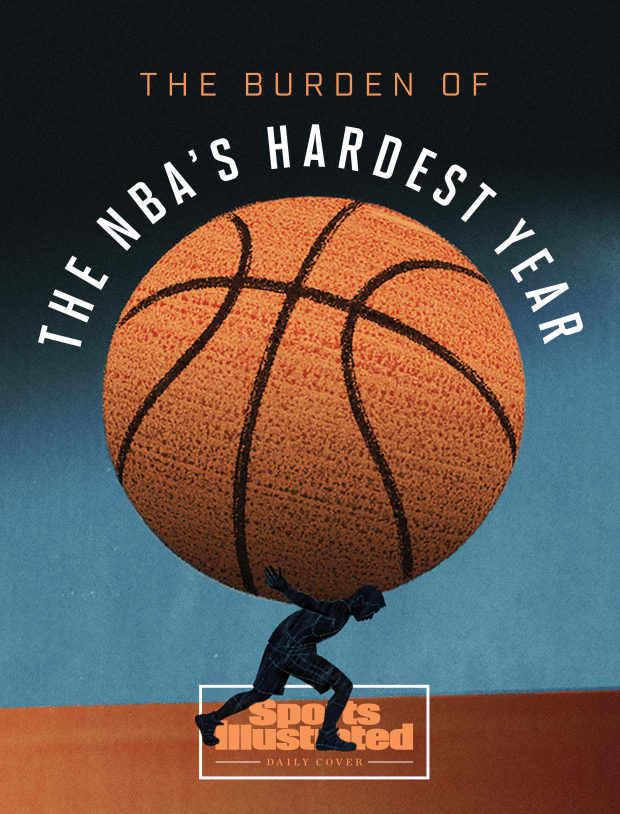
“Although we have special gifts and talents that make us seem more than human, at the end of the day we’re just people,” Gordon says. “With the same struggles and the same sufferings, the same day-to-day anxieties and insecurities that the rest of the world is going through.”
Players’ traumas have been layered. In addition to working through a global health crisis and performing in public before a mourning, increasingly fractured country, they were also confronted by a racial reckoning and social justice movement that called out for their contribution.
As Gordon sat in his hotel room, the trial of Derek Chauvin for killing George Floyd was days away from reaching a verdict, after weeks of heartbreaking testimony from eyewitnesses and Floyd’s loved ones. All season—and long before it began—relentless signs of racial inequality were “a constant strain on my mental health,” Gordon said. “I’m employed by the NBA. My job is to come out and compete and help my team win. But there’s just certain things that you can’t get out of your mind. It’s another reason why I do all of this mental health and mental training, because of how unfairly America treats Black men and Black women. And we’re still expected to come out, compete and act as if it’s not happening. It’s strenuous. Daily.”
NBA players are not a monolith, making it impossible to know precisely how mental health has affected their ability to perform this year. And there are innumerable variables that go into any game’s final score, with mental health being just one. But it’s also impossible to imagine a scenario where some thoughts and emotions felt off the floor would not carry over onto it. This was a season, after all, that featured notably uneven play: For most of this year, particularly after the All-Star break, the percentage of games that ended in a blowout was dramatically higher than usual.
“On the court, you want to be icey. You want to be really cool. You want to be composed,” Gordon says. “And when your mental is not right on the court, you do stupid things, like get technical fouls or compound mistakes. Like, say you miss a shot, you’re mad that you missed a shot so you turn around and foul somebody 80 feet away from the basket.”
Largely thanks to the need for teams and the league to preserve privacy, there is no available data on whether more players have taken advantage of mental health resources or whether they have experienced mental illness in greater numbers this season (according to a poll conducted by the American Psychological Association in November, 74% of psychologists reported seeing more patients with anxiety disorders compared to before the pandemic; 60% said the same for depression disorders). Anecdotally, though, in interviews with psychologists, psychiatrists and licensed mental health professionals who have experience treating NBA players, all agree that the need for help has swelled.
“The normal pressures that every player has had to contend with have been increasing in proportions that frighten me, frankly,” says Michele Roberts, the executive director of the National Basketball Players Association (NBPA). She adds that more players have called her about mental health resources in the past eight months than in her previous seven years on the job. “They’re expected to go out two or three times a week, perform at the highest level, and at the same time be husbands, fathers, boyfriends, sons, and on top of that deal with normal consequences of living in a pandemic. … We as a community don’t allow athletes the space to be vulnerable, and that’s wrong. They have as much right to be vulnerable as the rest of us. And in some ways, unlike many of us, they’ve got more reasons to be vulnerable.”
Heading into this season, commissioner Adam Silver knew potentially detrimental trade-offs would have to be made for games to be played. But as the year played out, he worried about the impact partial seclusion would have on players and their families. “I've been most concerned about how isolating both the pandemic has been generally, but more specific, the protocols that we and the players association felt were necessary to keep them COVID-free throughout the season,” Silver says. “We knew operating would entail enormous sacrifices … and there’s no question that it’s weighed heavily on all of us.”
Silver knew canceling the season would have created its own set of problems, including a massive financial hit for players, teams and employees throughout the league. It also would not have inoculated players from the pandemic’s impact on their day-to-day lives, from isolation to their risk of getting infected. But it’s still imperative to understand exactly what the sacrifices were. Next season is likely to be a return to “normal,” but even then there is little doubt that the mental health challenges presented by the 2020–21 season have altered and elevated the issue in a league that was already starting to pay attention. What this year has also told everyone involved: NBA teams and players are only scratching the surface of how consequential mental health really is.
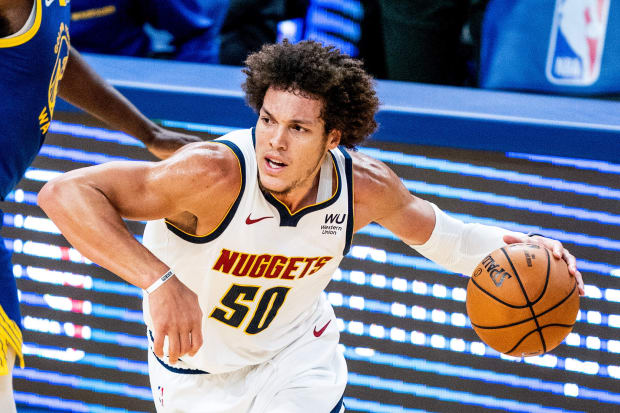
Before the bubble started, Roberts thought players’ games might actually benefit from being separated from their friends and family for such a prolonged period of time. There’d be nothing to distract them.
“I now know that was stupid,” she says. “It was a dumb thought. They don’t need to be isolated from their support systems to be better basketball players. In fact, quite the opposite: If they’re not sleeping well because they miss their families, if they’re engaged in borderline depression because of having to contend with isolation, that will impact their game.”
Down in Orlando, players were required to use an app that asked roughly five questions each morning about their health. One was, Would you like to talk to a mental health professional today? “I think we learned that you need to do more than tell them that there’s a program available or give them a brochure,” Silver says. “Like all effective communication, repetition is critically important. It’s unpredictable when someone might feel that need to talk to someone.”
Coming out of the bubble—a logistical success for the NBA in the sense that no players tested positive and a champion was crowned—the league knew how psychologically damaging that environment was and wanted to avoid anything like it in the future.
“As we began to discuss this season … it’s not to say [another bubble] was ruled out completely,” Silver says. “I think if the course of the pandemic had left us with no choice, we probably would have considered it again. But we knew it was our last option, not our first option.”
The league and union then negotiated parameters to push through a condensed 72-game, bubble-free regular season—starting after an all-too-brief offseason—that would include health and safety protocols. Games tipped off Dec. 22, quickly revealing the extent of the challenge. “Being in these big arenas, no fans, quick turnaround from last season, you’re going to have some people who are still getting their mind into the season,” Trail Blazers guard Damian Lillard said shortly after play kicked off.
About a week later, the NBA sent a private memo titled “Mental Health and Wellness Requirements and Recommended Practices for NBA Teams” to its 30 organizations. It was the third iteration of a similar document delivered over the last few years, and it featured input from psychiatrists, psychologists, physicians, trainers, coaches and “other mental health and wellness providers who work with NBA teams.”
For several obvious reasons, this version was more urgent than the first two. “We’re already on an 80-year upswing of anxiety, depression and mental health issues,” says Cavaliers forward Kevin Love, the NBA’s most outspoken mental health advocate. “And when you factor in COVID and social injustice [and], I mention it because it affects me and the people close to me, the wildfires and how all of the West Coast got ravaged, and then everything that happened with the election and before [Donald] Trump was out of office, there’s a heaviness to this time that we’re in.”
The NBA’s letter was filled with suggestions and mandates (some old, others new) that sought to help players navigate uncharted waters. It outlined how to preserve treatment-related confidentiality and called on teams to set up telehealth services so players could participate in talk therapy while avoiding any physical risk. Right before the 2019–20 season began, all 30 teams were required to employ at least one licensed mental health clinician; players were reminded to save that person’s number in their cellphone.
The memo wasn’t attempting to solve such a broad issue so much as reiterate how serious it is, and why, especially now, mental health deserves even more attention than it currently receives.
Dr. William Parham, a licensed, board-certified psychologist and director of the NBPA’s mental health and wellness program since it was created in 2018, spends some of his time connecting players to psychologists and psychiatrists in the union’s network (a different resource for players who would rather seek help from licensed mental health professionals who have no connection to their employer). He doesn’t have hard statistics, but Parham believes the number of requests he’s fielded for referrals has increased since the pandemic started.
Just after the NBA’s memo went out, the United States Capitol was attacked on Jan. 6 by insurrectionists who wanted to disrupt the transfer of power from one presidential administration to the next. It was horrifying for many reasons, including how it reminded Black citizens of the double standard that amplifies inequality in the country in which they were born.
The day was a mark on the never-ending chronology of systemic oppression that has been magnified over the past year by the police killings of George Floyd, Breonna Taylor, Rayshard Brooks, Daunte Wright and so many others.
One day before the Capitol’s siege, the district attorney in Kenosha, Wis., announced that charges would not be filed against the officer who shot Jacob Blake seven times in the back. On the night of the 6th, the Celtics and Heat responded by releasing a statement before their nationally televised game, denouncing the decision. They separately called out the inequitable response of law enforcement to the insurrectionists in Washington, compared with those protesting police brutality over the summer.
“It reminds me of what Dr. Martin Luther King said,” Celtics guard Jaylen Brown said after the game. “There are two Americas. In one America you get killed for sleeping in your car, selling cigarettes or playing in your backyard. And in another America you get to storm the Capitol. No tear gas, no massive arrests. None of that. … We want to keep conversations alive and do our part.”
All told, the U.S.’s acceptance of so much accumulated tragedy directly impacts the psyche of millions, including roughly 75% of all NBA players, who are Black. According to Dr. Kensa Gunter, a licensed psychologist who currently serves as director of the NBA’s Mind Health program, “The mental impact of being exposed to racial violence and trauma can be depression, it can be anger, it can be a sense of a foreshortened future. It can generate feelings of hopelessness and affect self-esteem. To see someone who looks like you in those scenarios, it affects you and it affects your mental health.”
In an attempt to react to matters happening in real time, Mind Health hosted private discussions before and during the bubble about the social justice movement. It allowed players to name their experience as Black men, how it shaped their world view and perspective and what they feel when they regularly see by nauseating images on television and their phones.
“The lynching by knee of George Floyd, that in itself was a devastating event to watch. [It] retriggered a number of feelings and emotions,” Parham says. “Mental health and wellness is sustained and maintained by a lot of current events. When you look at the voter suppression that is going on, when you look at Asian hate that is going on. All of those are ultimately tied to one’s mental health and wellbeing.”
Not everyone responds the same way, but for some the potential effect racial violence can have on the mind is severe. According to Dr. Wilsa Charles Malveaux, a psychiatrist who joined the NBPA’s independent network in 2019 and regularly treats NBA players, there are conditions, like adjustment disorder or acute stress disorder (which is similar to PTSD, except the symptoms last less than a month), that can develop.
As people of color with extraordinary platforms and a worldwide reach, some players feel obligated to get involved. That ability to impact change can be mentally beneficial—especially with the support of their employer. “Not being able to really talk to anybody else about it, or express how you feel about it or speak up for what you believe in, that's even more traumatic,” Malveaux says.
At the same time, try to put yourself in the shoes of a Black NBA player. Millions are scrutinizing what you say, criticizing you for not posting anything about the last police shooting or believing you should stay in your lane and focus on sports. They either discredit your worth or bestow a borderline-intolerable amount of praise.
There are players who feel like they should speak out against injustice but are afraid of the reaction or consequences. They might struggle with the weight of a giant megaphone that’s supplied by their status as one of the top 450 men’s basketball players in the world. Wasting that opportunity could be seen as selfish, even if verbalizing their views isn’t something everyone is equally comfortable doing. Not only is there pressure to express themselves, but players must also be knowledgeable while doing so.
“I have a job to spread accurate news, to spread accurate facts and just allow people to really see what’s going on in this world,” Blazers guard C.J. McCollum recently said on the Mentally Together podcast. “I feel like I have an obligation with a following with people who look up to me, with people who believe what I say. I want to make sure, first and foremost, I’m saying the right things, I’m saying the correct things. But I’m saying something that comes from the heart.”
It’s admirable and necessary, but far from effortless. “You’ve got the life in a pandemic, which is crazy as hell that all of us have to deal with,” Roberts says. “And then you’ve got a Black man watching police officers shoot people all the time and a community that says, ‘What are you gonna do about it? How are you gonna help us fix this?’ ”
A day after the insurrection, Nets guard Kyrie Irving took what essentially amounted to a leave of absence, citing “family and personal stuff” as an explanation when he returned two weeks later. During his first press conference back, Irving chewed over the load he carries as someone who’s fortunate enough to help others in need.
“I'm grateful because I’m able to stand on this platform with others alongside of me that have sacrificed and are going through similar things. So I'm not alone in this,” he said. “That’s just a big thing about, also, mental health, coming in and being balanced with yourself first and then being able to perform. With everything going on in the world politically, socially, it’s hard to ignore. I want to make changes daily. There are so many oppressed communities, so many things going on that are bigger than just a ball going in the rim.”
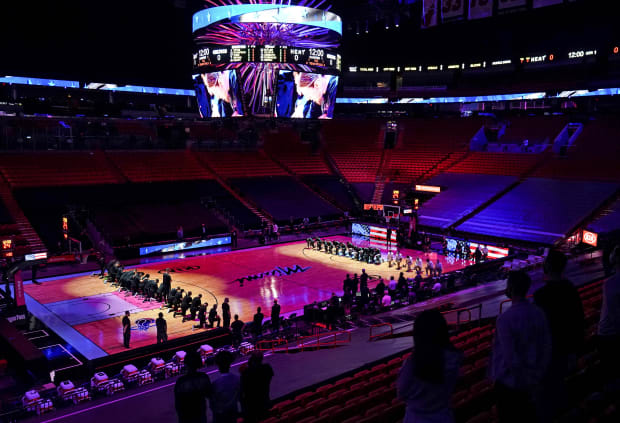
While players around the league strived to calibrate their responsibilities on the court with a duty to engage with a centuries-old problem off it, the pandemic continued to rage.
On Jan. 12, midway through Irving’s absence, the NBA and NBPA agreed that tighter health and safety protocols were necessary to ensure player safety and prevent COVID-19 from upending a truncated schedule that already seemed like a high-wire act.
“We learned the hard way that our protocols were not strict enough,” Silver says. “A few weeks into the season we were getting too many positive cases. And we recognized that we had to add some additional restrictions, plus additional testing, which all served to even further isolate them.”
Sixteen players had tested positive for the virus just one week before, and, as another wave spread across the country, games were postponed Jan. 10, 11 and 12. Another 10 games were postponed over the next week as outbreaks and contact-tracing issues beset multiple teams. In the league’s attempt to contain the virus, players were essentially forced to withdraw from society. On the road, they were prohibited from leaving the hotel or having any guests in their room. At home, they were barred from going outside and had to refrain from interacting with anyone who didn’t live with them. Multiple COVID-19 tests were required every day, which dominated their daily schedules and kept work at the forefront of their minds, all the time.
“Just seeing that facility that day, although you may not even go in and work out, but you drive into that facility every day. Mentally it’s exhausting,” said Warriors forward Draymond Green, appearing on the All-In podcast in early February. “It’s been a very tough season to say the least, and I think a lot of guys are struggling with it.”
Earlier this year, Denver’s Jamal Murray made a similar assertion. “My whole life now is an AAU tournament, only it’s one that never ends,” he told ESPN. “Game day. Off day. Ice, eat, sleep, start over. It's not healthy. But we're doing it."
Silver remembers one conversation had with a player around this time, someone on a new team, in a new city, away from his family. Every day was the same. He’d travel back and forth from his condo, to the practice facility, to the arena. Those were the only three places he saw.
“He said, ‘When I drive through town, people are starting to congregate again, sitting outdoors, at restaurants in nice weather. … I can smell the food on the tables and see people out in a celebratory way with each other,’ ” Silver remembers. “And he said, ‘I’m incredibly jealous. I recognize that people are looking at me and saying, ‘Wow, what an incredible life he has. But all I’m thinking about is, I just want to sit at one of those tables and hang around with a bunch of people and have lunch. And I’m not able to do that. And there’s no suggestion I can do it for the foreseeable future.’ ”
Gordon describes himself as “an introvert by nature” who initially didn’t mind the confinement. “But then after that you just miss being outside, you miss being with nature, you miss having the sun on your face,” he says. “As an NBA player, we eat, sleep and breathe basketball. But there has to be some sort of outlet for you to just kind of release and detach yourself from the game. And that wasn’t there for us.”
More importantly, players were also separated from their partners and children. (Roberts estimates that about half of all players don’t live with their families during the season.) “We’re playing with fire, not doing more,” Roberts told me in early February, referring to the growing mental health peril around the league. Some players were telling the union’s executive director that they’d take five COVID-19 tests every day if it meant they could see their families. During her many negotiations with the league, Roberts did her best to push back on protocol that limited contact with family, she says. “Because what I can’t do is repair the damage to your relationship with your wife that’s sustained because you have not seen her in months.”
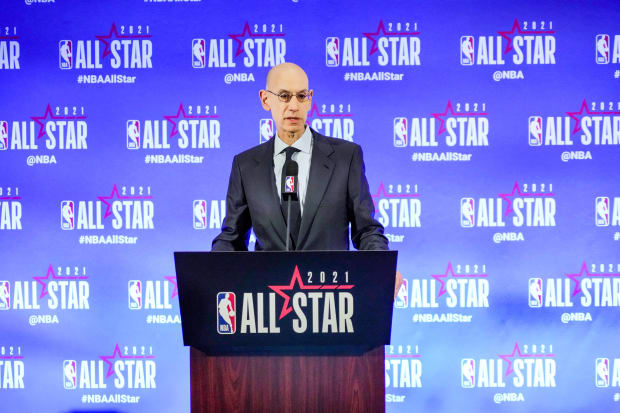
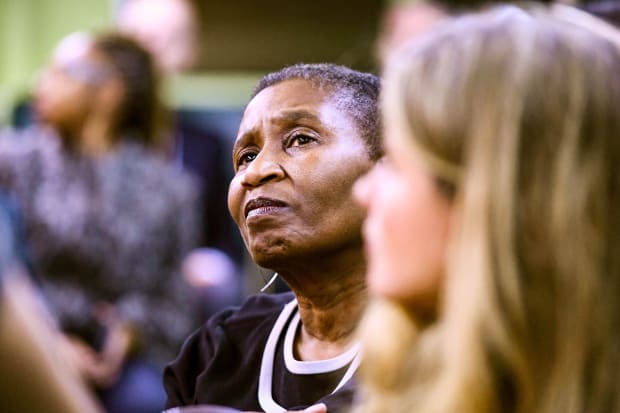
When asked how all the additional sources of anxiety have impacted the NBA’s product this season, Silver can’t say. “The answer is I’m not sure. Stress has taken a toll on the players, with the caveat that these are the very, very best in the world at what they do. Part of what makes them so incredibly successful is that unique ability to compartmentalize at such a high level, and to perform regardless of what's happening in their lives,” he says.
But Silver also acknowledges that “we could probably name a few players who would seem statistically off.” And he was quick to reaffirm that mental health affects players in important ways, pointing to Paul George’s experience in the bubble as an important example. During last year’s playoffs, after his Clippers defeated the Mavericks in Game 5 of their first-round series, George opened up. "I underestimated mental health, honestly. I had anxiety. A little bit of depression. Just being locked in here. I just wasn’t there. I checked out,” George told reporters. It was a seismic moment in the continuum of the league’s mental health awareness.
Many players compartmentalize to protect their games, but that is a skill, not a cure. Like Gordon said, basketball is a game of split-second decisions played at warp speed. If the mind is elsewhere, even for the blink of an eye, it increases the likelihood of an unfavorable outcome. Basketball is also a game driven by emotion, and at the end of the day everyone competing to win is a human being with a breaking point.
“If your mom is sick, it’s going to impact you on the floor, right?” says Robby Sikka, the vice president of basketball performance and technology for the Timberwolves. “If your dad is sick, how many guys want to talk about that?”
Dan O’Brien, the NBPA’s director of sport medicine and research, believes the season’s packed schedule contributed to sapping player’s mental stamina. Physical injuries are part of the game, but this year the recovery process has been more arduous to manage, thanks to the sheer number of games being played in a shorter time frame.
“There is absolutely a huge element related to physical injury and mental health,” O’Brien says. “ ‘What do my teammates think of me? I want to help them.’ And then you factor in the fans saying I’m stealing money from the organization, right? I think that is the major concern, in terms of mental health. Guys that are injured, how are they coping with that?”
Sleep was another factor that made consistently operating at a high level even harder. “Sleep in a normal year is hard, with travel. Sleep this year, with the testing interruptions, [was] even worse,” O’Brien says. “Mental health does affect sleep, and that can affect everything. If you sleep poorly it can affect on-court performance, it can affect readiness, it can affect heart rate, pretty much everything.”

On Jan. 27, the NBA and NBPA announced that their health and safety restrictions would slightly loosen. On the road, players could now spend one hour outside each day so long as they were back in their hotel room by 6 p.m. Up to four visitors were allowed, too, so long as they tested negative twice for COVID-19 and were willing to take a PCR test during and after the stay.
As the season progressed, players learned and leaned on different coping mechanisms, from prayer and religious readings, to meditation and breathing exercises, to journaling and unplugging from social media.
Giannis Antetokounmpo took daily 20-minute walks to clear his head and allow himself to escape from his job’s ceaseless pressures. “I think I’ve been doing a better job this year of enjoying this moment and not letting my mind explore as much …” Antetokounmpo told reporters in March. “Because at the end of the day, this is a stressful job that we’re doing.”
Celtics rookie point guard Payton Pritchard used tips learned in team-wide Zoom meetings with various mental health professionals to unhook from basketball when he’s not in the gym. “I try to have almost like two different lives,” Pritchard says. “When I’m not playing basketball I’m hanging out, being a kid.”
Therapy has been another way to manage obstacles and help identify the root of any pressing issue, to locate the fear that’s behind the anger or self-doubt, according to Malveaux.
After an in-game panic attack during the 2017-18 season, Love revealed his experience with depression. Three years later, he’s seen walls fall around people who were previously suffering or simply felt that therapy couldn’t do them good. Several players have reached out to Love this season, asking how they can seek help for themselves or a family member.
“With my therapist, I went to him the other day because I was going into the first stages of a pretty good spiral,” Love says. “But at the same time when things are going pretty well, and I'm happy, we get that first initial 20 minutes or so out of the way and then start going into ‘How can I better my life? How can I better other people’s lives?’ So it’s actually like a growth session.”
Gordon has embraced several forms of individual therapy throughout his NBA career, including from Dr. Shainna Ali (a licensed mental health counselor in Orlando) and a swami in Atlanta. “It just alleviates stress,” he says. “It helps take away some of the first-world problems that I think that I have. It puts things into perspective and just helps me to detach and see things for what they are and help me come back to the moment. That’s where I find my peace of mind, is in the moment.”
Meditation and the concept of mindfulness—or being conscious of the present—have become increasingly popular in the NBA over the past several years. The latter phrase, which helps some athletes stay in the moment during high-pressure in-game situations, was repeated frequently in conversations with players and psychologists for this story. But it’s also something that can help them away from the game, to calm a million thoughts and worries racing through their head at any given moment.
Hornets center Bismack Biyombo’s introduction to these tools came serendipitously back in 2015, during the All-Star break on a flight back from Los Angeles. Right after they took off, a woman seated next to Biyombo tapped him on the shoulder. During their conversation, she recommended a book called A Happy Pocket Full of Money. “I didn’t know [her], and she didn’t know me. And the book happened to change my life forever.” Biyombo read it in one sitting and, ever since, has meditated several times every day.
Growing up in the Democratic Republic of Congo with six younger siblings, Biyombo always believed he had to embody strength; regardless of what he was going through, signs of weakness were never an option. “It took me time to just be able to cry about something.”
When he was in high school, Kings guard Kyle Guy thought meditation was “for hippies.” Sudden panic attacks and bouts with anxiety when he was a star at the University of Virginia changed his view. Today, using the Calm app (a company LeBron James partnered with in December 2019), it’s the last thing he does before he falls asleep and the first thing he does in the morning. “I don’t use LeBron’s voice because I don’t want him talking to me every night before bed, so I use the generic lady voice,” Guy says, laughing. “It’s super soothing.”
As a two-way player compensated on a game-to-game basis, 2020 was financially difficult. He and his wife downsized to an apartment in Sacramento, and during the shortened offseason Guy had to deal with trainers who suddenly raised their rates to make up for lost business.
For therapeutic support, Guy talks to Galen Duncan, who has a Ph.D. in health psychology and has been the Kings’ vice president of professional development since 2017. Duncan has embedded himself with the players this season, monitoring COVID-19 protocols and making himself available when any other issues rise to the surface. “I’m just kind of in the fray to be there to help,” Duncan says. It speaks to how some teams have increasingly embraced the significance of individual wellness.
“I think mental health prior to the pandemic was something that was one of the things that we didn’t really openly discuss unless there was a crisis,” Sikka says. “It was something that we talked about when we found out that there was a player who was depressed. It was a very reactionary thing. Now we're talking about it as a proactive thing. … There’s no bad players in the NBA, just bad teams. The teams that suck are the ones that don’t develop people.”
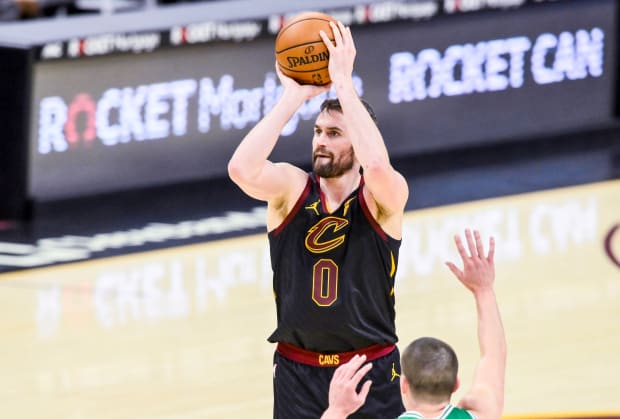
Mental health is inextricable from NBA history. From the psychological torture inflicted by white America on Black players during the civil rights era to those who saw their careers cut short due to mental illness in the 1990 and 2000s, before their organizations, the league or general society knew how to best handle everything they were going through.
“If you ask most of the guys back in the ’60s, ’70s, ’80s and ’90s, they’d be like, ‘Man, I wish I had [mental health resources],” says Derek Anderson, a former NBA player who in April was hired as a wellness counselor by the NBPA. “We didn’t know that we needed it ourselves, we just was taught to go on, deal with it in private and come back to work.”
The list of players who’ve spoken out about or been affected by mental health is long—DeMar DeRozan, Love, Metta Sandiford-Artest, Keyon Dooling, Ben Gordon, Royce White, Delonte West, Robert Covington and Kelly Oubre Jr., to name only a few—and those who used their own struggle to spread awareness have helped turn treatment into a priority for the league and union. The various consequences of this season have “accelerated the track we were on,” according to Silver.
But mental health is also a new frontier for teams that are still discovering how they can best fold wellness and therapeutic initiatives into day-to-day operations. Those challenges extend to the team-employed clinicians themselves, who participate in a monthly group call that’s organized by the league.
There, they compare notes and collectively gauge which methods are and aren’t working. Most evidence they have is anecdotal, since they lack the benefit of tangible data to inform strategic decision-making. None of this is easy, especially for the many players who insist they don’t need help to conquer whatever demons lie within.
And even though the war between nonacceptance and normalization has dramatically shifted toward the latter since 2018, there are still ways mental health remains a complicated subject. Most teams contacted for this story declined interview requests for relevant members of their organization, as did dozens of players who were invited separately to offer their perspective on the topic. Hurdles remain.
“I’m not going to pretend that the taboo isn’t still in full force. I’d love to see the taboo go away,” Roberts says. “If it takes 10 years before we all say, ‘Oh wow, who’s your counselor? I’ve got a great guy,’ that’s great. … The public acceptance will happen when it happens, but I want to make sure the availability of help is here now.”
There’s clear value when players spread awareness on a public stage, but mental health resources provided by the league, its teams and union are useful only if players feel comfortable taking advantage.
“Stigma is an emotional feeling,” Parham says. “People get embarrassed and ashamed, [but] I think to some degree … whether it’s to me or their team psychologists or somebody else, I think there’s going to be an increased request for support. … I think things are headed in the right direction. I think we've taken one step. We’ve not taken any quantum leaps.”
As the league detailed in its memo from January, mental health is a fluid, ever-evolving topic, both in how it’s considered and approached. Whatever ultimately comes out of this season is unknown, but the progress seen thus far, after a year that was inundated with hardship, is generally promising, albeit far from finished.
“I really feel like if we attack this head on and provide resources and just use our collective power to help each other and help heal people, we’re gonna be a way better league and we’re gonna be able to take that next step when it comes to treating mental health,” Love says.
“But my question is: What’s next?”
More SI Daily Covers:
• Police Killed George Floyd. An MMA Fighter Punched Back
• How the Suns Became Contenders Ahead of Schedule
• What You Haven’t Heard—But Need To Understand—About the Deshaun Watson Cases
• What the 76ers Need to Learn From the Bubble